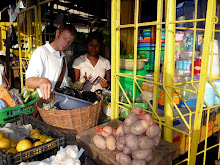While I was in Mali the rains came to Ghana and we are now officially in the rainy season. Harmattan is over and the temperatures will be cooler (I hope). After having seen how dry and hot it can be in Mali, I wrote this blog. It is a bit of a departure from what I usually post but I think that it is still pertains to my experience and this “Fulbright Year in Ghana”. Maybe the heat did finally get to me or maybe it is the prophylactic malaria drugs I have to take, but regardless, enjoy.
Hope Reigns Eternal…
A few weeks ago this was my life: Three am and I am still awake; lying in bed, staring up at the ceiling, trying not to move or sweat. My thermometer built into the clock next to my bed reads 86.7 degrees. I get up and turn up the ceiling fan to the maximum, 5, a speed at which it seems as if the entire fan will twist itself from the ceiling and come crashing down. However, my thought is not about the havoc it would reek on the room if such a crash were to occur, but simply that if it falls, the room would be left hotter still.
For me, one of the most difficult things to cope with here in Accra is the oppressive heat. On average the days are well into the 90’s and during the nights it does not usually drop below the mid 80’s.
Hope reigns eternal.
I can not speak to what the weather is usually like here in Accra, for I have only lived here for the past eight months. In terms of the time I have spent here, the first few months were very tolerable with rain a few times a week and the mornings were usually cloudy, holding off the power for the sun for a few hours. In late November or early December the dry season came and we went for weeks on end with no rain. The dry season here is called Harmatan in reference to the winds that blow south from the Sahara and bring the sand hundreds of miles so thick and heavy that the air is dry and hazy. It is so thick in the air that visibility is lessened, throats are dry, and lips crack.
Hope reigns eternal.
Then, the day before I returned from Mali, the rains came.
That smell that can only be found when rain hits dry earth for the first time in weeks, months. The feel of the cool breeze before the rains. The breeze after the rain that is still cool and hints at cooler and greener days to come. The inaudible deafening cry of all the plants and animals singing out, crying out, all in harmony, a life sustaining and refreshing sigh of thanks and relief.
The rains are life sustaining and life giving. They are a yearly occurrence that rejuvenate and regenerate all things living, and bring back to life things that appear to have been long dead. The rains give hope for cooler, better days to come: a rebirth. The rains give hope to a people, a nation, a culture that is oppressed not by a person, a political party, an economic depression, or any manmade enemy, but rather by the gods of the sky and the climate itself. A forlorn country is given a second chance; an opportunity for redemption and growth.
The rains everywhere in the world, or at least the few parts to which I have been, are important in one way or another. In many places crops, and the food that they produce, succeed or fail because of the rains. In other places the rains are an enemy that threatens to wash away villages, towns, and cities and the people that make those places their homes. But here in Ghana, the rains are life, and I can only imagine in many other places around the world. As the dry season wears on the heat becomes more and more oppressive, all that the plants, people, and animals can cling to is hope. Hope that the rains will come early. Hope that the rains will restore the color to the land. Hope that the rains will again give energy and enthusiasm to everything that drinks it. When the rains do finally come after what seems like an eternity, hope is realized in the water of life.
Hope reigns eternal.
 In Bobo we went exploring and found an old mosque in the city center Outside were many begger children and people praying. This old man is blind and the children take turns leading him around so that he can beg. When the camera came out they were all smiles.
In Bobo we went exploring and found an old mosque in the city center Outside were many begger children and people praying. This old man is blind and the children take turns leading him around so that he can beg. When the camera came out they were all smiles.



















































































